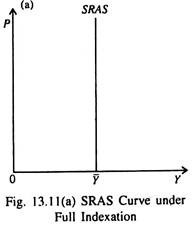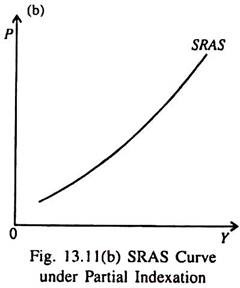Let us make an in-depth study of the Wage Indexation. After reading this article you will learn about: 1. Importance of Wage Indexation 2. Types of Wage Indexation.
Importance of Wage Indexation:
Wage indexation is important because labour markets do not clear instantaneously.
A complete indexation implies real wage rigidity, whereas the absence of indexation entails nominal wage rigidity in which changes in the price level directly affect the real wage.
The contract also specifies the determination of employment rule, which is assumed to be demand-determined.
ADVERTISEMENTS:
Consequently, employment in general will deviate from the flexible equilibrium level (i.e., from the employment level that will prevail in an economy where the wage is set as to clear the labour market continuously.) The optimal degree of indexation is designed so as to minimise the expected output deviation from its market clearing level.
The sticky wage model explains why firms pay wages more than the market clearing level. The model suggests one explanation of the upward sloping SRAS curve.
In this model three things happen when the price level rises:
(i) If the nominal wage is stuck, a rise in the price level lowers the real wage, reducing the real cost of labour.
ADVERTISEMENTS:
(ii) The lower real wage induces firms to hire more labour.
(iii) The additional labour hired produces more output.
This positive relationship between the price level and the amount of output means that the SRAS curve slopes upward during the period when the nominal wage cannot adjust.
According to this model the nominal wage is fixed on the basis of a long-term contract (for, say, 3 years or more). The nominal wage W is based on the target real wage W* and on the guesses of the expected price level Pe.
ADVERTISEMENTS:
So the nominal wage that is set is:
W= W*. Pe …(26)
After the nominal wage has been set and before hiring any labour, firms come to know exactly what the actual price level P is.
The real wage turns out to be:
W/P = w*(Pe/P)
Equation (25) implies that the real wage deviates from its target if the actual price level deviates from the expected price level. When P > Pe, W/P < w*. When P < Pe, W/P > w*. It is against this background that we study wage indexation which can be full or partial.
Types of Wage Indexation:
(i) Full Indexation:
Let us suppose wage contracts specify that the nominal wage is fully indexed for inflation. This means that the nominal wage is to be adjusted to fully compensate for changes in the CPI. In this case even the SRAS curve will be vertical because Y will not respond to changes in P.
This point may now be proved as:
Under full wage indexation:
ADVERTISEMENTS:
W = Pα, 0 < α < 1
where a is the proportionality factor.
If α = 1, dY/dp = 0. In case of full indexation, real wage remains constant, since nominal wage is fully adjusted to the current rate of inflation. Therefore the real cost of labour remains constant (and there is no change in the demand for labour) and Y remains constant even if P rises. So the AS curve is vertical. See Fig. 13.11(a).
ADVERTISEMENTS:
(ii) Partial Indexation:
In case of partial indexation, α < 1. This means that, for every increase in the CP/, the nominal wage rises, but by a smaller percentage than P. This implies that α – 1 < 0. So
FLL < 0, dY/dp > 0
In this case the real wage falls and thus the real cost of labour is reduced to its previous level. Therefore the demand for labour increases and so Y increases. Thus in this case the SRAS curve is upward sloping. See Fig. 13.11(b).
ADVERTISEMENTS:
Thus we get two types of SRAS curves under indexation. In case of full wage indexation it is vertical which means that Y does not respond to P. Under partial wage indexation the SRAS curve is upward sloping implying that Y responds positively to P.


